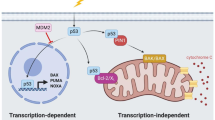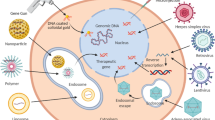Abstract
Targeting tumour suppressor gene pathways is an attractive therapeutic strategy in cancer. Since the first clinical trial took place in 1996, at least 20 other trials have investigated the possibility of restoring p53 function, either alone or in combination with chemotherapy, but with limited success. Other recent clinical trials have sought to harness abnormalities in the p53 pathway to permit tumour-selective replication of adenoviral vectors such as dl1520 (Onyx-015). Other tumour suppressor genes, such as retinoblastoma (Rb) and PTEN (phosphatase, tensin homologue, deleted on chromosome 10), are the targets for imminent clinical trials, while microarray technologies are revealing multiple new genes that are potential targets for future gene therapy.
This is a preview of subscription content, access via your institution
Access options
Subscribe to this journal
Receive 12 print issues and online access
$259.00 per year
only $21.58 per issue
Buy this article
- Purchase on Springer Link
- Instant access to full article PDF
Prices may be subject to local taxes which are calculated during checkout


Similar content being viewed by others
References
Rosenwald A et al. The use of molecular profiling to predict survival after chemotherapy for diffuse large-B-cell lymphoma. N Engl J Med 2002; 346: 1937–1947.
Khan J et al. Classification and diagnostic prediction of cancers using gene expression profiling and artificial neural networks. Nat Med 2001; 7: 673–679.
Buller RE et al. A phase I/II trial of rAd/p53 (SCH 58500) gene replacement in recurrent ovarian cancer. Cancer Gene Ther 2002; 9: 553–566.
Schuler M et al. Adenovirus-mediated wild-type p53 gene transfer in patients receiving chemotherapy for advanced non-small-cell lung cancer: results of a multicenter phase II study. J Clin Oncol 2001; 19: 1750–1758.
Kuball J et al. Successful adenovirus-mediated wild-type p53 gene transfer in patients with bladder cancer by intravesical vector instillation. J Clin Oncol 2002; 20: 957–965.
Pagliaro LC et al. Repeated intravesical instillations of an adenoviral vector in patients with locally advanced bladder cancer: a phase I study of p53 gene therapy. J Clin Oncol 2003; 21: 2247–2253.
Lang FF et al. Phase I trial of adenovirus-mediated p53 gene therapy for recurrent glioma: biological and clinical results. J Clin Oncol 2003; 21: 2508–2518.
Zeimet AG, Marth C . Why did p53 gene therapy fail in ovarian cancer? Lancet Oncol 2003; 4: 415–422.
Reles A et al. Correlation of p53 mutations with resistance to platinum-based chemotherapy and shortened survival in ovarian cancer. Clin Cancer Res 2001; 7: 2984–2997.
Vousden KH, Lu X . Live or let die: the cell's response to p53. Nat Rev Cancer 2002; 2: 594–604.
Wolf BB et al. Defective cytochrome c-dependent caspase activation in ovarian cancer cell lines due to diminished or absent apoptotic protease activating factor-1 activity. J Biol Chem 2001; 276: 34244–34251.
de Vries A et al. Targeted point mutations of p53 lead to dominant-negative inhibition of wild-type p53 function. Proc Natl Acad Sci USA 2002; 99: 2948–2953.
Bergamaschi D et al. p53 polymorphism influences response in cancer chemotherapy via modulation of p73-dependent apoptosis. Cancer Cell 2003; 3: 387–402.
Reid T et al. Intra-arterial administration of a replication-selective adenovirus (dl1520) in patients with colorectal carcinoma metastatic to the liver: a phase I trial. Gene Therapy 2001; 8: 1618–1626.
Hamid O et al. Phase II trial of intravenous CI-1042 in patients with metastatic colorectal cancer. J Clin Oncol 2003; 21: 1498–1504.
Vasey PA et al. Phase I trial of intraperitoneal injection of the E1B-55-kDa-gene-deleted adenovirus ONYX-015 (dl1520) given on days 1 through 5 every 3 weeks in patients with recurrent/refractory epithelial ovarian cancer. J Clin Oncol 2002; 20: 1562–1569.
Hecht JR et al. A phase I/II trial of intratumoral endoscopic ultrasound injection of ONYX-015 with intravenous gemcitabine in unresectable pancreatic carcinoma. Clin Cancer Res 2003; 9: 555–561.
Mulvihill S et al. Safety and feasibility of injection with an E1B-55 kDa gene-deleted, replication-selective adenovirus (ONYX-015) into primary carcinomas of the pancreas: a phase I trial. Gene Therapy 2001; 8: 308–315.
Reid T et al. Hepatic arterial infusion of a replication-selective oncolytic adenovirus (dl1520): phase II viral, immunologic, and clinical endpoints. Cancer Res 2002; 62: 6070–6079.
Dix BR et al. Does the antitumor adenovirus ONYX-015/dl1520 selectively target cells defective in the p53 pathway? J Virol 2001; 75: 5443–5447.
Ries SJ et al. Loss of p14ARF in tumor cells facilitates replication of the adenovirus mutant dl1520 (ONYX-015). Nat Med 2000; 6: 1128–1133.
Edwards SJ et al. Evidence that replication of the antitumor adenovirus ONYX-015 is not controlled by the p53 and p14(ARF) tumor suppressor genes. J Virol 2002; 76: 12483–12490.
Flesken-Nikitin A et al. Induction of carcinogenesis by concurrent inactivation of p53 and Rb1 in the mouse ovarian surface epithelium. Cancer Res 2003; 63: 3459–3463.
Sherr CJ, McCormick F . The RB and p53 pathways in cancer. Cancer Cell 2002; 2: 103–112.
Ip SM et al. pRb-expressing adenovirus Ad5-Rb attenuates the p53-induced apoptosis in cervical cancer cell lines. Eur J Cancer 2001; 37: 2475–2483.
Li D et al. The role of adenovirus-mediated retinoblastoma 94 in the treatment of head and neck cancer. Cancer Res 2002; 62: 4637–4644.
Zhang X et al. Adenoviral-mediated retinoblastoma 94 produces rapid telomere erosion, chromosomal crisis and caspase-dependent apoptosis in bladder cancer and immortalized human urothelial cells but not in normal urothelial cells. Cancer Res 2003; 63: 760–765.
Wills KN et al. Tissue-specific expression of an anti-proliferative hybrid transgene from the human smooth muscle alpha-actin promoter suppresses smooth muscle cell proliferation and neointima formation. Gene Therapy 2001; 8: 1847–1854.
Claudio PP et al. Mutations in the retinoblastoma-related gene RB2/p130 in lung tumors and suppression of tumor growth in vivo by retrovirus- mediated gene transfer. Cancer Res 2000; 60: 372–382.
Heise C et al. An adenovirus E1A mutant that demonstrates potent and selective systemic anti-tumoral efficacy. Nat Med 2000; 6: 1134–1139.
Fueyo J et al. A mutant oncolytic adenovirus targeting the Rb pathway produces anti-glioma effect in vivo. Oncogene 2000; 19: 2–12.
Bauerschmitz GJ et al. Treatment of ovarian cancer with a tropism modified oncolytic adenovirus. Cancer Res 2002; 62: 1266–1270.
Fueyo J et al. Preclinical characterization of the antiglioma activity of a tropism-enhanced adenovirus targeted to the retinoblastoma pathway. J Natl Cancer Inst 2003; 95: 652–660.
Jakubczak JL et al. An oncolytic adenovirus selective for retinoblastoma tumor suppressor protein pathway-defective tumors: dependence on E1A, the E2F-1 promoter, and viral replication for selectivity and efficacy. Cancer Res 2003; 63: 1490–1499.
Johnson L et al. Selectively replicating adenoviruses targeting deregulated E2F activity are potent, systemic antitumor agents. Cancer Cell 2002; 1: 325–337.
Branton PE, Roopchand DE . The role of adenovirus E4orf4 protein in viral replication and cell killing. Oncogene 2001; 20: 7855–7865.
Sharpless NE et al. Both products of the mouse Ink4a/Arf locus suppress melanoma formation in vivo. Oncogene 2003; 22: 5055–5059.
Modesitt SC et al. In vitro and in vivo adenovirus-mediated p53 and p16 tumor suppressor therapy in ovarian cancer. Clin Cancer Res 2001; 7: 1765–1772.
Turturro F et al. Effects of adenovirus-mediated expression of p27Kip1, p21Waf1 and p16INK4A in cell lines derived from t(2;5) anaplastic large cell lymphoma and Hodgkin's disease. Leukemia Lymphoma 2002; 43: 1323–1328.
Simon M et al. Conditional expression of the tumor suppressor p16 in a heterotopic glioblastoma model results in loss of pRB expression. J Neurooncol 2002; 60: 1–12.
Kawakami Y et al. Adenovirus-mediated p16 gene transfer changes the sensitivity to taxanes and Vinca alkaloids of human ovarian cancer cells. Anticancer Res 2001; 21: 2537–2545.
Hemmati PG et al. Adenovirus-mediated overexpression of p14(ARF) induces p53 and Bax-independent apoptosis. Oncogene 2002; 21: 3149–3161.
Kuo ML et al. Arf induces p53-dependent and -independent antiproliferative genes. Cancer Res 2003; 63: 1046–1053.
Lu W et al. Expression of p14ARF overcomes tumor resistance to p53. Cancer Res 2002; 62: 1305–1310.
Saadatmandi N et al. Growth suppression by a p14(ARF) exon 1beta adenovirus in human tumor cell lines of varying p53 and Rb status. Cancer Gene Ther 2002; 9: 830–839.
Tango Y et al. Adenovirus-mediated p14ARF gene transfer cooperates with Ad5CMV-p53 to induce apoptosis in human cancer cells. Hum Gene Ther 2002; 13: 1373–1382.
Yang CT et al. Adenovirus-mediated p14(ARF) gene transfer in human mesothelioma cells. J Natl Cancer Inst 2000; 92: 636–641.
Deng X et al. Recombinant adenovirus-mediated p14(ARF) overexpression sensitizes human breast cancer cells to cisplatin. Biochem Biophys Res Commun 2002; 296: 792–798.
Weber HO et al. Human p14(ARF)-mediated cell cycle arrest strictly depends on intact p53 signaling pathways. Oncogene 2002; 21: 3207–3212.
Eymin B et al. Human ARF binds E2F1 and inhibits its transcriptional activity. Oncogene 2001; 20: 1033–1041.
Fatyol K, Szalay AA . The p14ARF tumor suppressor protein facilitates nucleolar sequestration of hypoxia-inducible factor-1alpha (HIF-1alpha ) and inhibits HIF-1-mediated transcription. J Biol Chem 2001; 276: 28421–28429.
Karayan L et al. Human ARF protein interacts with topoisomerase I and stimulates its activity. Oncogene 2001; 20: 836–848.
Eymin B et al. p14ARF induces G2 arrest and apoptosis independently of p53 leading to regression of tumours established in nude mice. Oncogene 2003; 22: 1822–1835.
Stahl JM et al. Loss of PTEN promotes tumor development in malignant melanoma. Cancer Res 2003; 63: 2881–2890.
Fernandez M, Eng C . The expanding role of PTEN in neoplasia: a molecule for all seasons? Clin Cancer Res 2002; 8: 1695–1698.
Huang H et al. PTEN induces chemosensitivity in PTEN-mutated prostate cancer cells by suppression of Bcl-2 expression. J Biol Chem 2001; 276: 38830–38836.
Yuan XJ, Whang YE . PTEN sensitizes prostate cancer cells to death receptor-mediated and drug-induced apoptosis through a FADD-dependent pathway. Oncogene 2002; 21: 319–327.
Davies MA et al. Adenoviral-mediated expression of MMAC/PTEN inhibits proliferation and metastasis of human prostate cancer cells. Clin Cancer Res 2002; 8: 1904–1914.
Tanaka M, Grossman HB . In vivo gene therapy of human bladder cancer with PTEN suppresses tumor growth, downregulates phosphorylated Akt, and increases sensitivity to doxorubicin. Gene Therapy 2003; 10: 1636–1642.
Huang J, Kontos CD . PTEN modulates vascular endothelial growth factor-mediated signaling and angiogenic effects. J Biol Chem 2002; 277: 10760–10766.
Wen S et al. PTEN controls tumor-induced angiogenesis. Proc Natl Acad Sci USA 2001; 98: 4622–4627.
Abe T et al. PTEN decreases in vivo vascularization of experimental gliomas in spite of proangiogenic stimuli. Cancer Res 2003; 63: 2300–2305.
Ekmekcioglu S et al. Down-regulated melanoma differentiation associated gene (mda-7) expression in human melanomas. Int J Cancer 2001; 94: 54–59.
Saeki T et al. Tumor-suppressive effects by adenovirus-mediated mda-7 gene transfer in non-small cell lung cancer cell in vitro. Gene Ther 2000; 7: 2051–2057.
Mhashilkar AM et al. Melanoma differentiation associated gene-7 (mda-7): a novel anti-tumor gene for cancer gene therapy. Mol Med 2001; 7: 271–282.
Saeki T et al. Inhibition of human lung cancer growth following adenovirus-mediated mda-7 gene expression in vivo. Oncogene 2002; 21: 4558–4566.
Pataer A et al. Adenoviral transfer of the melanoma differentiation-associated gene 7 (mda7) induces apoptosis of lung cancer cells via up-regulation of the double-stranded RNA-dependent protein kinase (PKR). Cancer Res 2002; 62: 2239–2243.
Mhashilkar AM et al. MDA-7 negatively regulates the beta-catenin and PI3K signaling pathways in breast and lung tumor cells. Mol Ther 2003; 8: 207–219.
Ramesh R et al. Melanoma differentiation-associated gene 7/interleukin (IL)-24 is a novel ligand that regulates angiogenesis via the IL-22 receptor. Cancer Res 2003; 63: 5105–5113.
Sellar GC et al. OPCML at 11q25 is epigenetically inactivated and has tumor-suppressor function in epithelial ovarian cancer. Nat Genet 2003; 34: 337–343.
Author information
Authors and Affiliations
Rights and permissions
About this article
Cite this article
McNeish, I., Bell, S. & Lemoine, N. Gene Therapy Progress and Prospects: cancer gene therapy using tumour suppressor genes. Gene Ther 11, 497–503 (2004). https://doi.org/10.1038/sj.gt.3302238
Received:
Accepted:
Published:
Issue Date:
DOI: https://doi.org/10.1038/sj.gt.3302238
Keywords
This article is cited by
-
Stem cell therapy in sensorineural hearing loss: a systematic review
The Egyptian Journal of Otolaryngology (2023)
-
Tumor suppressor NGX6 inhibits the growth and metastasis of multiple cancers
Tumor Biology (2016)
-
Packaging, Amplification, and Appraisal of the Recombinant Tumor-Selective Type I Herpes Simplex Virus Carrying GALV.fus Gene
Cell Biochemistry and Biophysics (2014)
-
Chlorotoxin-conjugated nanoparticles as potential glioma-targeted drugs
Journal of Neuro-Oncology (2012)



